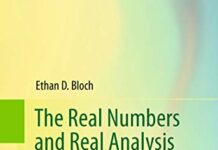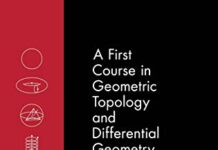
Ebook Info
- Published: 2011
- Number of pages: 384 pages
- Format: PDF
- File Size: 2.14 MB
- Authors: Ethan D. Bloch
Description
“Proofs and Fundamentals: A First Course in Abstract Mathematics” 2nd edition is designed as a “transition” course to introduce undergraduates to the writing of rigorous mathematical proofs, and to such fundamental mathematical ideas as sets, functions, relations, and cardinality. The text serves as a bridge between computational courses such as calculus, and more theoretical, proofs-oriented courses such as linear algebra, abstract algebra and real analysis. This 3-part work carefully balances Proofs, Fundamentals, and Extras. Part 1 presents logic and basic proof techniques; Part 2 thoroughly covers fundamental material such as sets, functions and relations; and Part 3 introduces a variety of extra topics such as groups, combinatorics and sequences. A gentle, friendly style is used, in which motivation and informal discussion play a key role, and yet high standards in rigor and in writing are never compromised. New to the second edition: 1) A new section about the foundations of set theory has been added at the end of the chapter about sets. This section includes a very informal discussion of the Zermelo– Fraenkel Axioms for set theory. We do not make use of these axioms subsequently in the text, but it is valuable for any mathematician to be aware that an axiomatic basis for set theory exists. Also included in this new section is a slightly expanded discussion of the Axiom of Choice, and new discussion of Zorn’s Lemma, which is used later in the text. 2) The chapter about the cardinality of sets has been rearranged and expanded. There is a new section at the start of the chapter that summarizes various properties of the set of natural numbers; these properties play important roles subsequently in the chapter. The sections on induction and recursion have been slightly expanded, and have been relocated to an earlier place in the chapter (following the new section), both because they are more concrete than the material found in the other sections of the chapter, and because ideas from the sections on induction and recursion are used in the other sections. Next comes the section on the cardinality of sets (which was originally the first section of the chapter); this section gained proofs of the Schroeder–Bernstein theorem and the Trichotomy Law for Sets, and lost most of the material about finite and countable sets, which has now been moved to a new section devoted to those two types of sets. The chapter concludes with the section on the cardinality of the number systems. 3) The chapter on the construction of the natural numbers, integers and rational numbers from the Peano Postulates was removed entirely. That material was originally included to provide the needed background about the number systems, particularly for the discussion of the cardinality of sets, but it was always somewhat out of place given the level and scope of this text. The background material about the natural numbers needed for the cardinality of sets has now been summarized in a new section at the start of that chapter, making the chapter both self-contained and more accessible than it previously was. 4) The section on families of sets has been thoroughly revised, with the focus being on families of sets in general, not necessarily thought of as indexed. 5) A new section about the convergence of sequences has been added to the chapter on selected topics. This new section, which treats a topic from real analysis, adds some diversity to the chapter, which had hitherto contained selected topics of only an algebraic or combinatorial nature. 6) A new section called “You Are the Professor” has been added to the end of the last chapter. This new section, which includes a number of attempted proofs taken from actual homework exercises submitted by students, offers the reader the opportunity to solidify her facility for writing proofs by critiquing these submissions as if she were the instructor for the course. 7) All known errors have been corrected. 8) Many minor adjustments of wording have been made throughout the text, with the hope of improving the exposition.
User’s Reviews
Editorial Reviews: Review “This is a well-written book, based on very sound pedagogical ideas. It would be an excellent choice as a textbook for a ‘transition’ course.” (Margret Höft, zbMATH 1012.00013, 2021)“The contents of the book is organized in three parts … . this is a nice book, which also this reviewer has used with profit in his teaching of beginner students. It is written in a highly pedagogical style and based upon valuable didactical ideas.” (R. Steinbauer, Monatshefte für Mathematik, Vol. 174, 2014)“Books in this category are meant to teach mathematical topics and techniques that will become valuable in more advanced courses. This book meets these criteria. … This book is well suited as a textbook for a transitional course between calculus and more theoretical courses. I also recommend it for academic libraries.” (Edgar R. Chavez, ACM Computing Reviews, February, 2012)“This is an improved edition of a good book that can serve in the undergraduate curriculum as a bridge between computationally oriented courses like calculus and more abstract courses like algebra.” (Teun Koetsier, Zentralblatt MATH, Vol. 1230, 2012) From the Back Cover This textbook is designed to introduce undergraduates to the writing of rigorous mathematical proofs, and to fundamental mathematical ideas such as sets, functions, relations, and cardinality. The book serves as a bridge between computational courses such as calculus and more theoretical courses such as linear algebra, abstract algebra, and real analysis. This second edition has been significantly enhanced, while maintaining the balance of topics and careful writing of the previous edition. Part 1 presents logic and basic proof techniques; Part 2 thoroughly covers fundamental material such as sets, functions and relations; and Part 3 introduces a variety of extra topics such as groups, combinatorics and sequences, and suggests avenues for independent student explorations. A gentle, friendly style is used, in which motivation and informal discussion play a key role, and yet high standards in rigor and in writing are never compromised. Reviews of the first edition: This is a well-written book, based on very sound pedagogical ideas. It would be an excellent choice as a textbook for a ‘transition’ course.―Zentralblatt Math’Proofs and Fundamentals’ has many strengths. One notable strength is its excellent organization… There are large exercise sets throughout the book… the exercises are well integrated with the text and vary appropriately from easy to hard… Perhaps the book’s greatest strength is the author’s zeal and skill for helping students write mathematics better.―MAA Online About the Author Dr. Ethan D. Bloch of Bard College is the author of two Springer publications “A First Course in Geometric Topology and Differential Geometry,” and the first and second editions of, “Proofs and Fundamentals: A First Course in Abstract Mathematics.” More information about Dr. Ethan D. Bloch can be found on his person web page: http://math.bard.edu/bloch Read more
Reviews from Amazon users which were colected at the time this book was published on the website:
⭐I think that the book bindings were made with cheap materials, taking into account that this book costs 40+ dollars, and probably made in United States. I expected that the book will be sewn in blocks and then glued. This book is only glued and sheets can fell apart if you fully open the book. You can compare this book crafting with a more cheap Dover book but instead with a hard cover, such a pain. I recommend that the bookbinding should be specified in the item description. This kind of books (hardcovers) and specially those of mathematics must last for many decades!
⭐Excellent book and eventhough is used the state is great! Without any problem.
⭐This book has an innovative teaching approach that encourages the reader from the beginning to work independently on writing proofs and learning basics of the discipline. The text is written in a precise and enyojable way, and therefore recommend it for introductory courses, or for people interested in learning basic math topics.
⭐This undergraduate book was required in my math class. Self teaching with this book is not impossible, but rather difficult if you do not know all the mathematical symbols. Overall great book
⭐The book is well structured and the topics are clearly explained, however the binding on my copy (as well as the teacher’s copy) broke. Hopefully they will improve the quality of the binding in the next edition.
⭐This book has NO solution guide or hints for excercises. The examples are obvious while the excercises are brutal. This book is designed for students who plan to live at their professors office hours. Sections written to help write proofs don’t explain the setup and the why, Just the form.
⭐This book is so bad, lack of explanation and proofs, just give you theorem and let you proof it by yourselves. With no solution given.
⭐The content is very good, but its explanation is too long and wordy. This made me so bored. Try “How to Prove It: A Structured Approach” by Daniel J. Velleman instead.
⭐Gud
Keywords
Free Download Proofs and Fundamentals: A First Course in Abstract Mathematics (Undergraduate Texts in Mathematics) in PDF format
Proofs and Fundamentals: A First Course in Abstract Mathematics (Undergraduate Texts in Mathematics) PDF Free Download
Download Proofs and Fundamentals: A First Course in Abstract Mathematics (Undergraduate Texts in Mathematics) 2011 PDF Free
Proofs and Fundamentals: A First Course in Abstract Mathematics (Undergraduate Texts in Mathematics) 2011 PDF Free Download
Download Proofs and Fundamentals: A First Course in Abstract Mathematics (Undergraduate Texts in Mathematics) PDF
Free Download Ebook Proofs and Fundamentals: A First Course in Abstract Mathematics (Undergraduate Texts in Mathematics)

